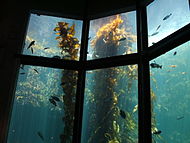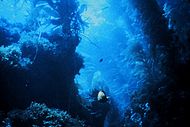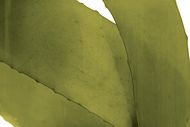Kelp
| Kelp Temporal range: [1]
| |
|---|---|
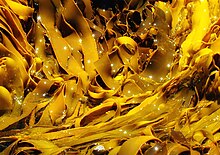
| |
| Scientific classification | |
| Domain: | Eukaryota |
| Clade: | Diaphoretickes |
| Clade: | SAR |
| Clade: | Stramenopiles |
| Phylum: | Gyrista |
| Subphylum: | Ochrophytina |
| Class: | Phaeophyceae |
| Order: | Laminariales Migula, 1909[2] |
| Families | |
|
Agaraceae Chordaceae Laminariaceae Lessoniaceae Pseudochordaceae
| |
Kelps are large brown algae or seaweeds that make up the order Laminariales. There are about 30 different genera.[3] Despite its appearance, kelp is not a plant but a stramenopile, a group containing many protists.[4]
Kelp grows in "underwater forests" (kelp forests) in shallow oceans, and is thought to have appeared in the Miocene, 5 to 23 million years ago.[5] The organisms require nutrient-rich water with temperatures between 6 and 14 °C (43 and 57 °F). They are known for their high growth rate—the genera Macrocystis and Nereocystis can grow as fast as half a metre a day, ultimately reaching 30 to 80 metres (100 to 260 ft).[6]
Through the 19th century, the word "kelp" was closely associated with seaweeds that could be burned to obtain
Description

In most kelp, the thallus (or body) consists of flat or leaf-like structures known as blades. Blades originate from elongated stem-like structures, the stipes. The holdfast, a root-like structure, anchors the kelp to the substrate of the ocean. Gas-filled bladders (pneumatocysts) form at the base of blades of American species, such as Nereocystis lueteana, (Mert. & Post & Rupr.)[6] to hold the kelp blades close to the surface.
Growth and reproduction
Growth occurs at the base of the
The parenchymatous thalli are generally covered with a mucilage layer, rather than cuticle.[9]
Taxonomy
Phylogeny
Under evolution by
Some kelp species including giant kelp, have evolved transport mechanisms for organic as well as
Apart from undergoing convergent evolution with plants, species of kelp have undergone convergent evolution within their own phylogeny that has led to niche conservatism.[15] This niche conservatism means that some species of kelp have convergently evolved to share similar niches, as opposed to all species diverging into distinct niches through adaptive radiation. A 2020 study looked at functional traits (blade mass per area, stiffness, strength, etc.) of 14 species of kelp and found that many of these traits evolved convergently across kelp phylogeny. With different species of kelp filling slightly different environmental niches, specifically along a wave disturbance gradient, many of these convergently evolved traits for structural reinforcement also correlate with distribution along that gradient. The wave disturbance gradient that this study refers to is the environments that this kelp inhabit have a varied level of perturbation from the tide and waves that pull at the kelp. It can be assumed from these results that niche partitioning along wave disturbance gradients is a key driver of divergence between closely related kelp.[15]
Due to the often varied and turbulent habitat that kelp inhabit, plasticity of certain structural traits has been a key for the evolutionary history of the phyla. Plasticity helps with a very important aspect of kelp adaptations to ocean environments, and that is the unusually high levels of morphological homoplasy between lineages. This in fact has made classifying brown algae difficult.[16] Kelp often have similar morphological features to other species within its own area since the roughness of the wave disturbance regime, but can look fairly different from other members of its own species that are found in different wave disturbance regimes. Plasticity in kelps most often involves blade morphology such as the width, ruffle, and thickness of blades.[17] Just one example is the giant bull kelp Nereocystis luetkeana, which have evolved to change blade shape in order to increase drag in water and interception of light when exposed to certain environments. Bull kelp are not unique in this adaptation; many kelp species have evolved a genetic plasticity for blade shapes for different water flow habitats. So individuals of the same species will have differences to other individuals of the same species due to what habitat they grow in.[18] Many species have different morphologies for different wave disturbance regimes[17] but giant kelp Macrocystis integrifolia has been found to have plasticity allowing for 4 distinct types of blade morphology depending on habitat.[19] Where many species only have two or three different blade shapes for maximizing efficiency in only two or three habitats. These different blade shapes were found to decrease breakage and increase ability to photosynthesize. Blade adaptations like these are how kelp have evolved for efficiency in structure in a turbulent ocean environment, to the point where their stability can shape entire habitats. Apart from these structural adaptations, the evolution of dispersal methods relating to structure have been important for the success of kelp as well.
Kelp have had to adapt
Prominent species
- Bull kelp, Nereocystis luetkeana, a northwestern American species. Used by coastal indigenous peoples to create fishing nets.
- Giant kelp, Pacific coast of North America and South America.
- Kombu, Saccharina japonica (formerly Laminaria japonica) and others, several edible species of kelp found in Japan.
Species of Laminaria in the British Isles;
- Laminaria digitata (Hudson) J.V. Lamouroux (Oarweed; Tangle)
- Laminaria hyperborea (Gunnerus) Foslie (Curvie)
- Laminaria ochroleuca Bachelot de la Pylaie
- Saccharina latissima(Linnaeus) J.V.Lamouroux (sea belt; sugar kelp; sugarwack)
Species of Laminaria worldwide, listing of species at AlgaeBase:[24]
- Laminaria agardhii (NE. America)
- Laminaria bongardina Postels et Ruprecht (Bering Sea to California)
- Laminaria cuneifolia (NE. America)
- Laminaria dentigeraKlellm. (California - America)
- Laminaria digitata (NE. America)
- Laminaria ephemera Setchell (Sitka, Alaska, to Monterey County, California - America)
- Laminaria farlowii Setchell (Santa Cruz, California, to Baja California - America)
- Laminaria groenlandica (NE. America)
- Laminaria longicruris (NE. America)
- Laminaria nigripes (NE. America)
- Laminaria ontermedia (NE. America)
- Laminaria pallida Greville ex J. Agardh (South Africa)
- Laminaria platymeris (NE. America)
- Laminaria saccharina (Linnaeus) Lamouroux, synonym of Saccharina latissima(north east Atlantic Ocean, Barents Sea south to Galicia - Spain)
- Laminaria setchellii Silva (Aleutian Islands, Alaska to Baja California America)
- Laminaria sinclairii (Harvey ex Hooker f. ex Harvey) Farlow, Anderson et Eaton (Hope Island, British Columbia to Los Angeles, California - America)
- Laminaria solidungula (NE. America)
- Laminaria stenophylla (NE. America)

Other species in the
- Alaria esculenta (North Atlantic)[25]
- Alaria marginata Post. & Rupr. (Alaska and California - America)
- Costaria costata (C.Ag.) Saunders (Japan; Alaska, California - America)
- Ecklonia brevipes J. Agardh (Australia; New Zealand)
- Ecklonia maxima (Osbeck) Papenfuss (South Africa)
- Ecklonia radiata (C.Agardh) J. Agardh (Australia; Tasmania; New Zealand; South Africa)
- Eisenia arborea Aresch. (Vancouver Island, British Columbia, Montrey, Santa Catalina Island, California - America)
- Egregia menziesii(Turn.) Aresch.
- Hedophyllum sessile (C.Ag.) Setch (Alaska, California - America)
- Macrocystis pyrifera(Linnaeus, C.Agardh) (Australia; Tasmania and South Africa)
- Pleurophycus gardneri Setch. & Saund. (Alaska, California - America)
- Pterygophora californica Rupr. (Vancouver Island, British Columbia to Bahia del Ropsario, Baja California and California - America)
Non-Laminariales species that may be considered as kelp:
- )
- Durvillea willana, Fucales (New Zealand)
- Durvillaea potatorum (Labillardière) Areschoug, Fucales (Tasmania; Australia)

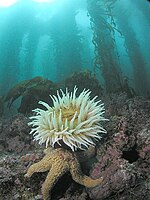
Ecology
Kelp forests
Kelp may develop dense forests with high production,
Interactions
Some animals are named after the kelp, either because they inhabit the same
- graceful kelp crab(Pugettia gracilis), Pacific coast of North America.
- blenny) (e.g., Heterosticbus rostratus, genus Gibbonsia), Pacific coast of North America.
- Kelp goose (kelp hen) (Chloephaga hybrida), South America and the Falkland Islands
- Kelp pigeon (sheathbill) (Chionis alba and Chionis minor), Antarctic
Conservation
Overfishing nearshore ecosystems leads to the degradation of kelp forests. Herbivores are released from their usual population regulation, leading to over-grazing of kelp and other algae. This can quickly result in barren landscapes where only a small number of species can thrive.[34][35] Other major factors which threaten kelp include marine pollution and the quality of water, climate changes and certain invasive species.[36]
Uses
| Nutritional value per 100 g (3.5 oz) | |
|---|---|
| Energy | 180 kJ (43 kcal) |
9.57 g | |
| Sugars | 0.6 |
| Dietary fiber | 1.3 g |
0.56 g | |
1.68 g | |
Niacin (B3) | 3% 0.47 mg |
| Pantothenic acid (B5) | 13% 0.642 mg |
| Folate (B9) | 45% 180 μg |
| Vitamin C | 3% 3 mg |
| Vitamin E | 6% 0.87 mg |
| Vitamin K | 55% 66 μg |
| Minerals | Quantity %DV† |
| Calcium | 13% 168 mg |
| Iron | 16% 2.85 mg |
| Magnesium | 29% 121 mg |
| Manganese | 9% 0.2 mg |
| Phosphorus | 3% 42 mg |
| Potassium | 3% 89 mg |
| Sodium | 10% 233 mg |
| Zinc | 11% 1.23 mg |
| †Percentages estimated using US recommendations for adults,[37] except for potassium, which is estimated based on expert recommendation from the National Academies.[38] | |
Giant kelp can be harvested fairly easily because of its surface canopy and growth habit of staying in deeper water.
Kelp ash is rich in iodine and alkali. In great amount, kelp ash can be used in soap and glass production. Until the Leblanc process was commercialized in the early 19th century, burning of kelp in Scotland was one of the principal industrial sources of soda ash (predominantly sodium carbonate).[39] Around 23 tons of seaweed was required to produce 1 ton of kelp ash. The kelp ash would consist of around 5% sodium carbonate.[40]
Once the Leblanc Process became commercially viable in Britain during the 1820s, common salt replaced kelp ash as raw material for sodium carbonate. Though the price of kelp ash went into steep decline, seaweed remained the only commercial source of iodine. To supply the new industry in iodine synthesis, kelp ash production continued in some parts of West and North Scotland, North West Ireland and Guernsey. The species
Kombu (昆布 in Japanese, and 海带 in Chinese, Saccharina japonica and others), several Pacific species of kelp, is a very important ingredient in Chinese, Japanese, and Korean cuisines. Kombu is used to flavor broths and stews (especially dashi), as a savory garnish (tororo konbu) for rice and other dishes, as a vegetable, and a primary ingredient in popular snacks (such as tsukudani). Transparent sheets of kelp (oboro konbu) are used as an edible decorative wrapping for rice and other foods.[47]
Kombu can be used to soften beans during cooking, and to help convert indigestible sugars and thus reduce flatulence.[48]

In Russia, especially in the Russian Far East, and former Soviet Union countries several types of kelp are of commercial importance: Saccharina latissima, Laminaria digitata, Saccharina japonica. Known locally as "Sea Cabbage" (Морская капуста in Russian), it comes in retail trade in dried or frozen, as well as in canned form and used as filler in different types of salads, soups and pastries.[49]
Because of its high concentration of iodine, brown kelp (
In 2010, researchers found that
Kelp's rich iron content can help prevent iron deficiency.[53]
Commercial production
Commercial production of kelp harvested from its natural habitat has taken place in Japan for over a century. Many countries today produce and consume laminaria products; the largest producer is China.
In culture

Some of the earliest evidence for human use of marine resources, coming from Middle Stone Age sites in South Africa, includes the harvesting of foods such as abalone, limpets, and mussels associated with kelp forest habitats.
In 2007, Erlandson et al. suggested that kelp forests around the Pacific Rim may have facilitated the dispersal of anatomically modern humans following a coastal route from Northeast Asia to the Americas. This "kelp highway hypothesis" suggested that highly productive kelp forests supported rich and diverse marine food webs in nearshore waters, including many types of fish, shellfish, birds, marine mammals, and seaweeds that were similar from Japan to California, Erlandson and his colleagues also argued that coastal kelp forests reduced wave energy and provided a linear dispersal corridor entirely at sea level, with few obstacles to maritime peoples. Archaeological evidence from California's Channel Islands confirms that islanders were harvesting kelp forest shellfish and fish, beginning as much as 12,000 years ago.
During the Highland Clearances, many Scottish Highlanders were moved on to areas of estates known as crofts, and went to industries such as fishing and kelping (producing soda ash from the ashes of kelp). At least until the 1840s, when there were steep falls in the price of kelp, landlords wanted to create pools of cheap or virtually free labour, supplied by families subsisting in new crofting townships. Kelp collection and processing was a very profitable way of using this labour, and landlords petitioned successfully for legislation designed to stop emigration. The profitability of kelp harvesting meant that landlords began to subdivide their land for small tenant kelpers, who could now afford higher rent than their gentleman farmer counterparts.[54] But the economic collapse of the kelp industry in northern Scotland during the 1820s led to further emigration, especially to North America.[citation needed]
Natives of the
In Chinese slang, "kelp" (simplified Chinese: 海带; traditional Chinese: 海帶; pinyin: hǎi dài), is used to describe an unemployed returnee.[clarification needed] It has negative overtones, implying the person is drifting aimlessly, and is also a homophonic expression (Chinese: 海待; pinyin: hǎidài, literally "sea waiting"). This expression is contrasted with the employed returnee, having a dynamic ability to travel across the ocean: the "sea turtle" (simplified Chinese: 海龟; traditional Chinese: 海龜; pinyin: hǎi gūi) and is also homophonic with another word (simplified Chinese: 海归; traditional Chinese: 海歸; pinyin: hǎi gūi, literally "sea return").
Gallery
-
Giant kelp in Monterey Bay Aquarium's Kelp Forest exhibit
-
Blue rockfish in kelp forest
-
An underwater shot of a kelp forest
-
A close up view of Ecklonia maxima, giant brown kelp
-
Washed-up kelp found along the coast of La Jolla Shores
-
Scuba diving in a kelp forest in California
See also
- Bladder wrack – Species of Phaeophyceae
- Blue carbon – Carbon stored in coastal and marine ecosystems
- Durvillaea, also known as southern bull kelps – Genus of seaweeds
- Wrack zone – Coastal area where organic material is deposited at high tide
- Sea lettuce – Genus of seaweeds
- Aquaculture of giant kelp
References
- ISBN 978-0-08-047535-6. Retrieved 1 April 2013.
- ^ Migula, W. (1909). Kryptogamen-Flora von Deutschland, Deutsch-Österreich und der Schweiz. Band II. Algen. 2. Teil. Rhodophyceae, Phaeophyceae, Characeae. Gera: Verlag Friedriech von Zezschwitz. pp. i–iv, 1–382, 122 (41 col.) pls.
- .
- S2CID 86227768.
- ^ University of California Museum of Paleontology: The Miocene Epoch
- ^ ISBN 0-565-09175-1
- ^ "Kelp," in Oxford English Dictionary (Second Edition). Oxford University Press, 1989. Retrieved 1 December 2006
- ^ Norderhaug, KM., Christie, H. 2009. Sea urchin grazing and kelp re-vegetation in the NE Atlantic. Marine Biology Research 5: 515-528. Estuarine, Coastal and Shelf Science 95: 135-144
- OCLC 223742770.
- ^ Darwin, C. The Voyage of the Beagle; P. F. Collier & Son Corporation: New York, 1860
- ^ PMID 26423844.
- PMID 21729086.
- PMID 20412862.
- S2CID 84778708.
- ^ ISSN 0269-8463.
- S2CID 83876632.
- ^ PMID 21669836.
- ^ Lobban, C. S., Wynne, M. J., & Lobban. (1981). The Biology of Seaweeds. University of California Press.
- S2CID 84195060.
- ISSN 0171-8630.
- S2CID 204850695.
- ISSN 0171-8630.
- S2CID 206183570.
- ^ AlgaeBase Laminariales
- ^ "Dabberlocks (Alaria esculenta)". The Marine Life Information Network. Retrieved 1 August 2019.
- PMID 36103524.
- ^ Abdullah, M.I., Fredriksen, S., 2004. Production, respiration and exudation of dissolved organic matter by the kelp Laminaria hyperborea along the west coast of Norway. Journal of the Marine Biological Association of the UK 84: 887.
- ^ Rinde, E., 2009. Dokumentasjon av modellerte marine Naturtyper i DNs Naturbase. Førstegenerasjonsmodeller til kommunenes startpakker for kartlegging av marine naturtyper 2007. NIVA report, 32 pp.
- ^ Christie, H., Jørgensen, N.M., Norderhaug, K.M., Waage-Nielsen, E., 2003. Species distribution and habitat exploitation of fauna associated with kelp (Laminaria hyperborea) along the Norwegian coast. Journal of the Marine Biological Association of the UK 83, 687-699.
- ^ Jørgensen, N.M., Christie, H., 2003. l Diurnal, horizontal and vertical dispersal of kelp associated fauna. Hydrobiologia 50, 69-76.
- ^ Norderhaug, K.M., Christie, H., Rinde, E., 2002. Colonisation of kelp imitations by epiphyte and holdfast fauna; a study of mobility patterns. Marine Biology 141, 965-973.
- ^ Christie et al., 2003
- ^ Norderhaug, K.M., Christie, H., 2009. Sea urchin grazing and kelp re-vegetation in the NE Atlantic. Marine Biology Research 5, 515-528.
- ^ Dayton, P.K. 1985a. Ecology of kelp communities. Annual Review of Ecology and Systematics 16: 215-245.
- ^ Sala, E., C.F. Bourdouresque and M. Harmelin-Vivien. 1998. Fishing, trophic cascades, and the structure of algal assemblages: evaluation of an old but untested paradigm. Oikos 82: 425-439.
- ^ Planet, Team (2012-01-12). "Green Glossary: Kelp Forests: Other Marine Life: Animal Planet". Animals.howstuffworks.com. Archived from the original on 2012-10-24. Retrieved 2013-02-12.
- ^ United States Food and Drug Administration (2024). "Daily Value on the Nutrition and Supplement Facts Labels". Retrieved 2024-03-28.
- )
- OCLC 243798097.
- ^ Jonathan Pereira, Fred B. Kilmer, The Elements of Materia Medica and Therapeutics, Volume 1, 1854, p. 558
- ^ Edward C. C. Stanford, Wentworth L. Scott, ‘The Economic Applications of Seaweed’, February 14, 1862, Journal of the Royal Society of Arts, Vol 10, No. 482, 185-199
- ^ John J. McKetta Jr. Taylor & Francis, Encyclopaedia of Chemical Processing and Design: Volume 27 - Hydrogen Cyanide to Ketones Dimethyl (Acetone), 1988, p. 283
- ISBN 9783540926795. Retrieved 2019-01-25.
- PMID 15628997.
- PMID 32625597.
- ^ Powers, John M. Powers. Craig's Restorative Dental Materials, 12th Edition. C.V. Mosby, 022006. p. 270
- ISBN 0-681-32327-2
- ISBN 0-7607-1740-0
- ^ "Features of the Far Eastern cuisine". www.eastrussia.ru. Archived from the original on 2021-01-16. Retrieved 2021-01-14.
- ^ Iodine Helps Kelp Fight Free Radicals and May Aid Humans, Too Newswise, Retrieved on July 8, 2008.
- PMID 24342882.
- ^ "Is Seaweed The Answer To A Dieter's Prayer?". Sky News. March 22, 2010. Archived from the original on March 25, 2010. Retrieved March 23, 2010.
- PMID 27009567.
- ^ J. M. Bumsted, The People's Clearance: Highland Emigration to British North America, 1770-1815, 1981
- ^ [1] allwords.com definition for "Kelper",
- ^ [2] dictionary.com definition for "Kelper"
Further reading
- Druehl, L.D. 1988. Cultivated edible kelp. in Algae and Human Affairs. Lembi, C.A. and Waaland, J.R. (Editors) 1988.ISBN 0 521 32115 8.
- Erlandson, J.M., M.H. Graham, B.J. Bourque, D. Corbett, J.A. Estes, & R.S. Steneck. 2007. The Kelp Highway hypothesis: marine ecology, the coastal migration theory, and the peopling of the Americas. Journal of Island and Coastal Archaeology 2:161-174.
- Eger, A. M., Layton, C., McHugh, T. A, Gleason, M., and Eddy, N. (2022). Kelp Restoration Guidebook: Lessons Learned from Kelp Projects Around the World. The Nature Conservancy, Arlington, VA, USA.
External links
 Media related to Laminariales at Wikimedia Commons
Media related to Laminariales at Wikimedia Commons Data related to Laminariales at Wikispecies
Data related to Laminariales at Wikispecies

